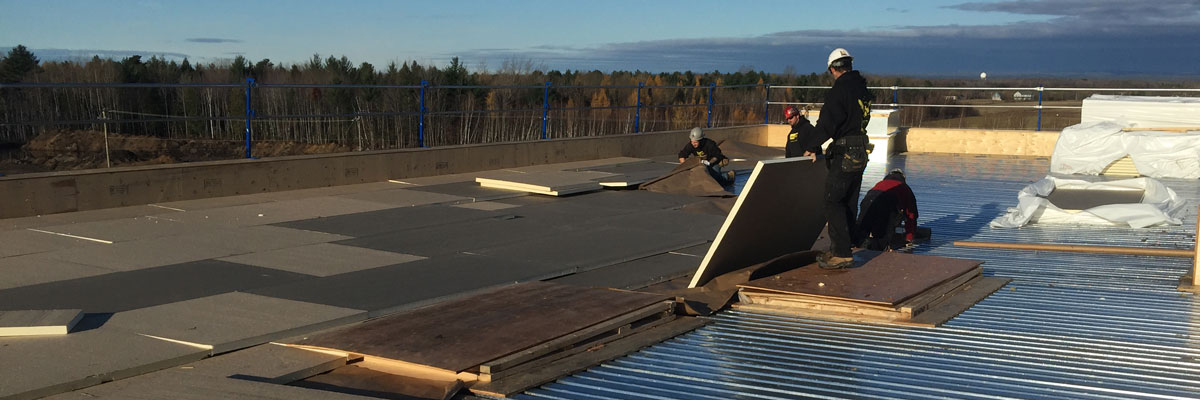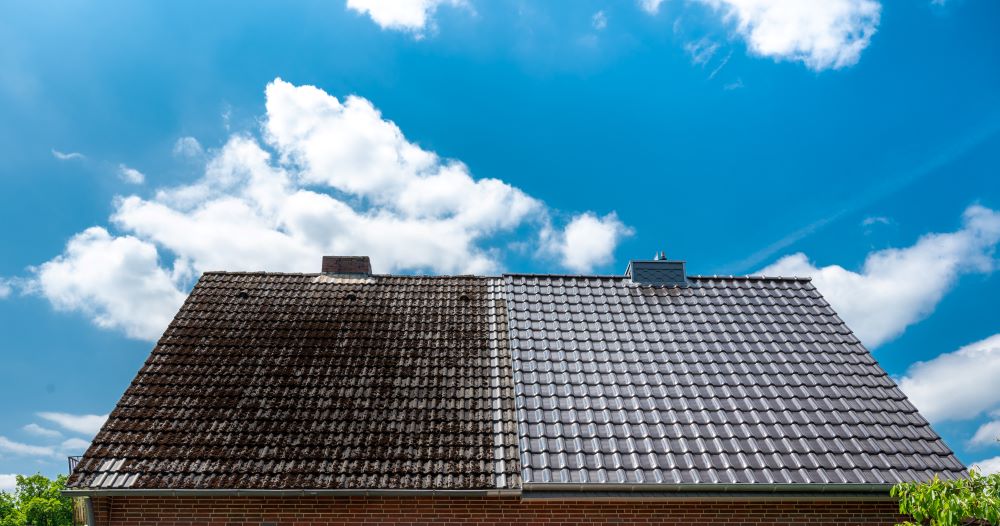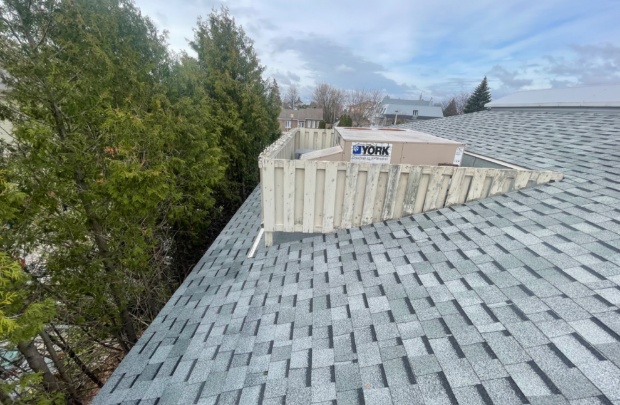Asphalt shingles can wear out over time or from exposure to the harsh Quebec weather. If you notice broken, cracked or missing shingles on your building, act quickly to avoid bigger problems like water leaks or seepage.
Whether you’re a DIY enthusiast or you prefer to call in a professional, this technical job requires some special knowledge and practical expertise. It’s a job that must be done properly to guarantee a fully functioning, trouble-free roof.
To help you protect your building, our Montreal roofers explain when and how to repair an asphalt shingle roof!
What are the signs that asphalt shingles need repair?
Identifying signs of wear and tear is the only way to decide when to replace or repair asphalt shingles. You may be surprised to learn that some types of damage demand urgent roof repairs.
Visible discolouration
Increased exposure to the sun, especially on south-facing homes, can lead to the shingle discolouration. This is a problem that mainly affects your home’s appearance, but it can also be a sign of more serious underlying problems.
As soon as you notice discolouration on asphalt shingles, take a closer look or hire professionals to examine or renovate your pitched roof.
Broken or lifted shingles
Broken or lifted asphalt shingles are another sign of wear and tear that shouldn’t be taken lightly. These can be signs of a faulty roof coating, improper installation, or overheating caused by insulation or ventilation issues. In winter, broken or lifted asphalt shingles can lead to seepage and other problems.
Granule loss is not as severe as breakage, but it is another sign of aging. If asphalt shingles warp, there is likely a problem with the substrate beneath them. If the base is made of wood, it’s possible that humidity has caused swelling or contraction. This is not the same as uplift and needs your urgent attention!
Missing shingles
If sections of asphalt shingles are missing, it’s usually because they’ve been torn off by wind or other severe weather. Roof maintenance or snow removal can also result in torn shingles, especially if you use the wrong tools or techniques.
Missing nails or glue can also lead to lost shingles. Whatever the cause, missing roof parts need to be replaced immediately to prevent larger problems that could affect the entire building. If you wait and the condition of your roof worsens, you may have to replace the entire asphalt shingle system.
While wear and tear on asphalt shingles is unavoidable over time, some shingles are more durable than others. Keep this in mind when making a purchase.
Moss and moisture
Often the only visible evidence of moisture on roofs is moss on the rooftop or mold in the attic. Black or brownish stains can also indicate that roof moisture has spread to the cladding. A simple way to protect your building is to clean your asphalt shingle roof regularly.
If the moisture problem spreads to the entire structure, a complete re-roof may be necessary. Before proceeding, get a professional roof inspection. It takes an experienced professional to give you appropriate advice.
Preparing for asphalt shingle roof repairs
Before you begin repairing your asphalt shingle roof, you will need to get ready. There are a few important points to consider.
Tools and materials
Make sure you have all the necessary tools and materials at hand before starting the repair.
- Claw hammer: for removing nails and damaged shingles
- Utility knife: to cut and remove damaged shingles
- New asphalt shingles: replacement shingles that match those already on your roof
- Roofing nails: to secure new shingles in place
- Wire stripping pliers: to remove damaged shingles
- Roof mastic: to seal shingles and make the roof watertight
- Secure ladder or scaffolding: for safe access to your roof
- Work gloves and goggles: to protect you during the repairs
With all necessary tools and materials ready, you’ll avoid unnecessary trips back and forth, and you can devote your full concentration to your roof repairs.
Safety precautions
Safety should be a top priority when repairing your asphalt shingle roof. Make sure to verify the security of the site and equipment before climbing on your roof! Here are some essential precautions:
- Use a strong, safe ladder, and verify that it is stable before climbing onto your roof.
- Wear non-slip shoes to avoid slipping on shingles.
- If possible, work in pairs. Having someone else on site can make the process safer and more efficient.
- Avoid working on your roof in windy, slippery or rainy conditions.
- Make sure the area around your ladder is clear of people and debris while you’re working.
- If you’re not comfortable with working at height, consider calling in a professional to do the repairs for you.
By taking these safety precautions, you can minimize the risks involved in repairing your roof, and work with peace of mind.
How to repair asphalt shingles
Let’s get down to the nitty-gritty of repairing an asphalt shingle roof. There are six key steps in the process:
Step 1: Clean the affected area
Before beginning repairs, clean the damaged area of your roof thoroughly. Remove any debris, dirt or residue that could get in the way. Use a stiff brush or broom to remove leaves, branches or other foreign matter.
Step 2: Remove damaged shingles
Use a claw hammer to remove all nails, being careful not to damage adjacent shingles. Use a utility knife to dislodge and remove the damaged shingles.
Step 3: Prepare the surface
Before installing new shingles, you have to prepare the raw surface. If your roof’s underlayment is damaged, now is the time to replace it. Make sure the surface is clean, dry and smooth. If necessary, remove any adhesive or mastic residue.
Step 4: Install new shingles
Now it’s time to install the new asphalt shingles. Start by aligning the first shingle and nailing it down. Continue with other shingles, following the manufacturer’s guidelines for overlap, making sure as you go that your asphalt shingles are always in line and spaced equally.
Step 5: Securing and sealing shingles
Use roofing nails to secure your new asphalt shingles. Make sure you drive them in deep enough to anchor them securely to the surface. Next, apply roofing adhesive or mastic to the edges of the shingles to seal them. Proper sealing helps prevent water infiltration and makes your roof more durable.
Step 6: Final inspection and site clean-up
Once the repair is complete, take the time to inspect your work. Check that your asphalt shingles are properly attached, aligned and sealed. Make sure there are no damaged or missing shingles left to replace. Collect all debris and waste from the repair and make sure you leave the area clean and safe.
Caution: Never attempt to install new asphalt shingles on top of the existing shingles. If you want your roof to be watertight, shingles must be installed on a flat, even surface.
Preventing future damage to asphalt shingles
Once you’ve repaired your asphalt shingle roof, there are a few things you can do to prevent further damage:
- Regular roof maintenance: Schedule periodic roof inspections to detect any early signs of damage or wear. By spotting problems at an early stage, you’ll be able to treat them quickly and prevent them from getting worse.
- Debris removal: Clean your roof regularly. Leaves, branches and other debris can trap moisture and cause shingles to deteriorate.
- Moss and fungus control: Keep an eye on your roof, and if you spot moss, lichen or fungus, use specialized products or call in a professional to eliminate them safely.
- Manage water build-up: Check that your rain gutters and drainage systems are in good working order. Water build-up can lead to infiltration and damage, so clean your eavestroughs regularly to make sure they are properly draining water away from your roof.
- UV protection: Apply a protective coating or use asphalt shingles with UV protection to minimize the degradation caused by UV rays.
- Tree pruning: Prune nearby trees regularly to prevent branches from rubbing against shingles during turbulent weather.
With regular maintenance and vigilance, you can extend the lifespan of your roof and minimize the risk of future damage.
Contact Duro-Toit Roofers for asphalt shingle repairs
Repairing an asphalt shingle roof may not seem that complex, but not everyone can do the job. Working at height on a roof involves a certain element of risk, in addition to the knowledge needed to detach and install shingles correctly and safely. Calling on specialized roofers is often the best solution.
At Duro-Toit, we understand the importance of a healthy roof, and our professionals have everything it takes to do professional and reliable repairs.
Contact us today! Our team will be happy to repair your asphalt shingles safely and efficiently.



